Immigrant Health Access Challenges in US Healthcare System
VerifiedAdded on 2023/04/25
|7
|1628
|479
Essay
AI Summary
This essay analyzes the US healthcare system's impact on immigrant health, focusing on access to care, health insurance, and the role of medical technology. It highlights the challenges immigrants face, including insurance coverage, cultural competence in care delivery, and government support. The essay discusses the Affordable Care Act, Medicare, and demographic trends, particularly the aging population, and their effects on healthcare access. It identifies disparities in care for immigrant communities, emphasizing the need for improved coverage, culturally sensitive training for healthcare professionals, and community support. The essay concludes by advocating for continuous improvements in healthcare infrastructure, addressing the evolving nature of illnesses, and enhancing patient satisfaction through better access to services and care.
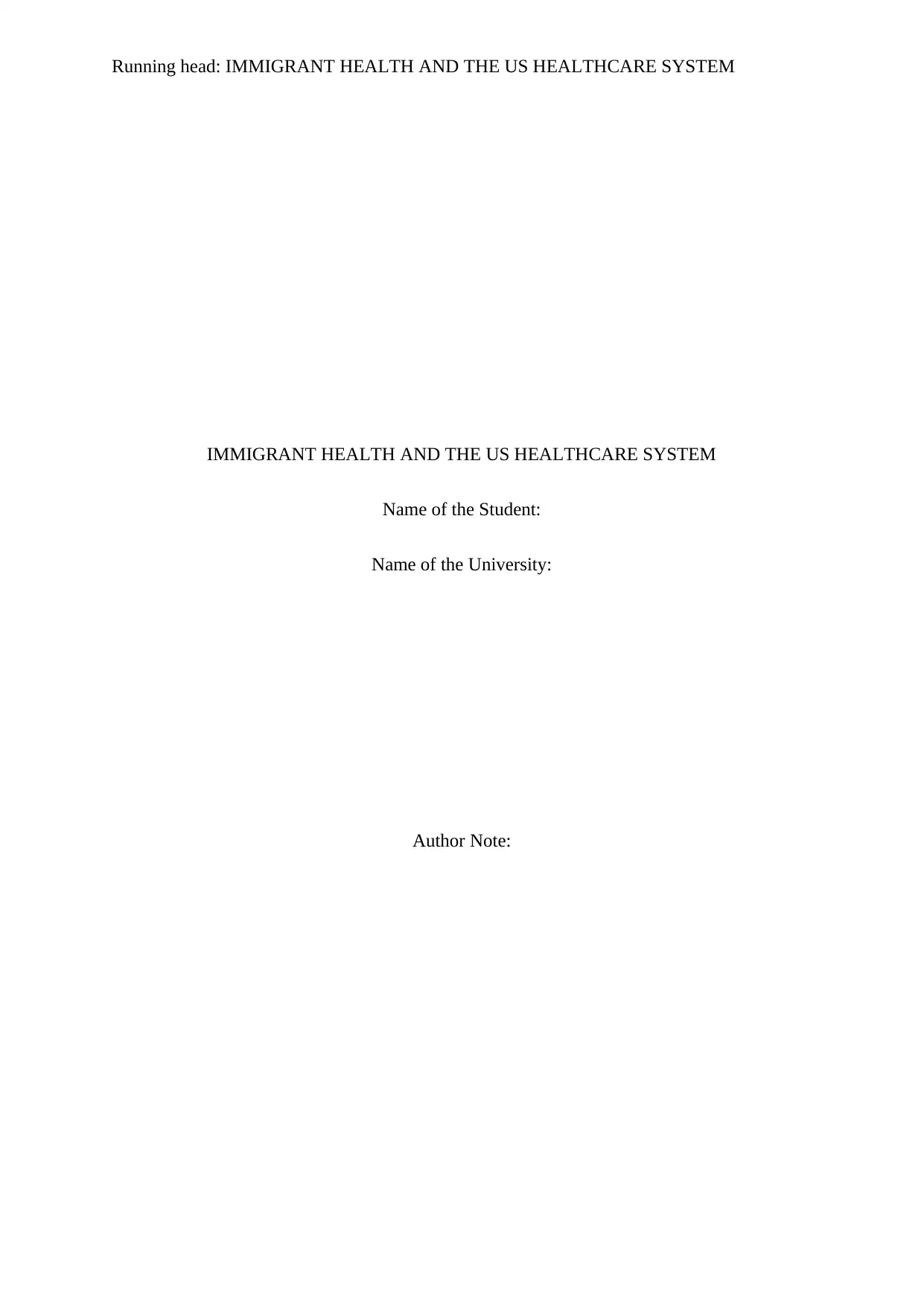
Running head: IMMIGRANT HEALTH AND THE US HEALTHCARE SYSTEM
IMMIGRANT HEALTH AND THE US HEALTHCARE SYSTEM
Name of the Student:
Name of the University:
Author Note:
IMMIGRANT HEALTH AND THE US HEALTHCARE SYSTEM
Name of the Student:
Name of the University:
Author Note:
Paraphrase This Document
Need a fresh take? Get an instant paraphrase of this document with our AI Paraphraser
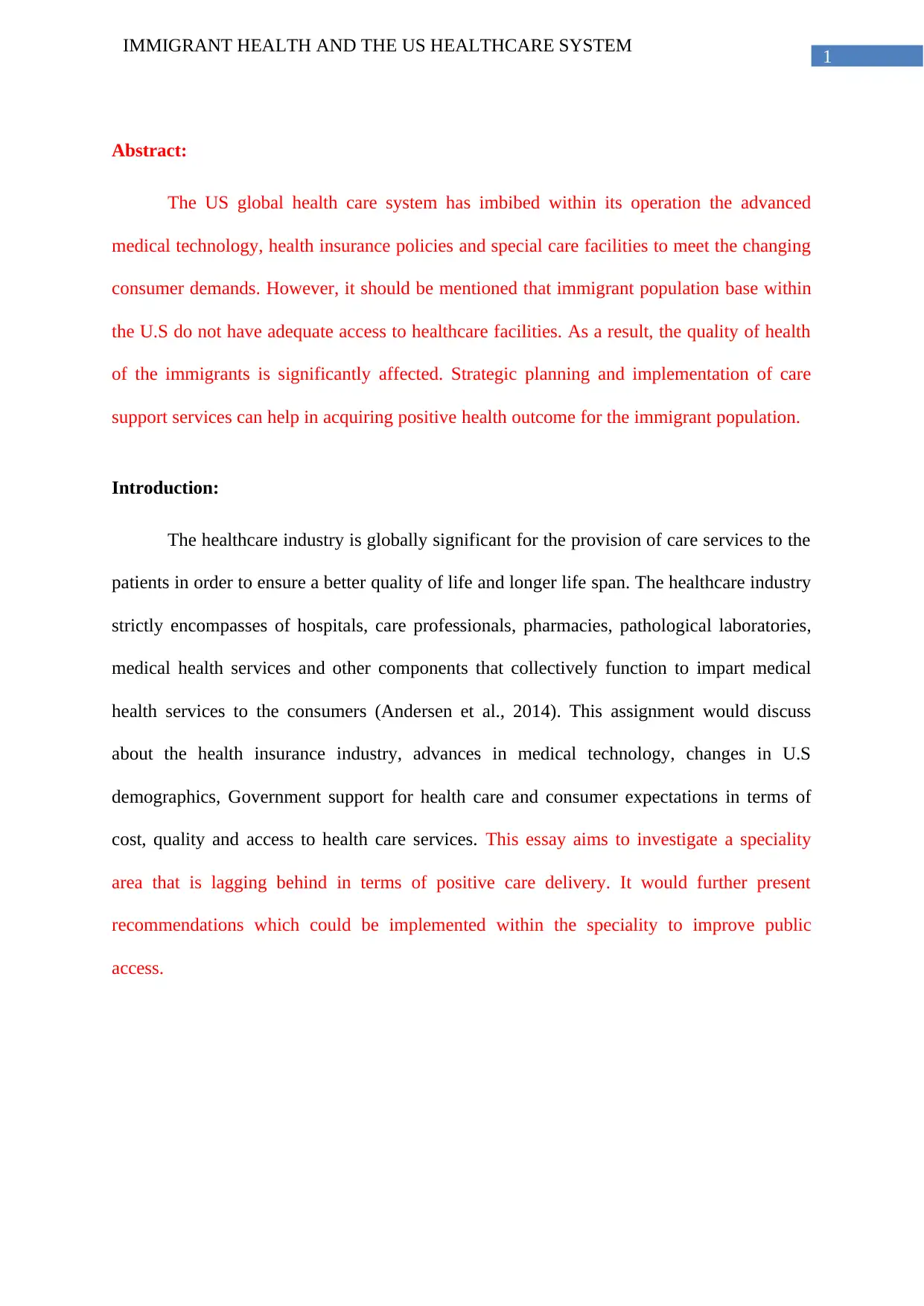
1
IMMIGRANT HEALTH AND THE US HEALTHCARE SYSTEM
Abstract:
The US global health care system has imbibed within its operation the advanced
medical technology, health insurance policies and special care facilities to meet the changing
consumer demands. However, it should be mentioned that immigrant population base within
the U.S do not have adequate access to healthcare facilities. As a result, the quality of health
of the immigrants is significantly affected. Strategic planning and implementation of care
support services can help in acquiring positive health outcome for the immigrant population.
Introduction:
The healthcare industry is globally significant for the provision of care services to the
patients in order to ensure a better quality of life and longer life span. The healthcare industry
strictly encompasses of hospitals, care professionals, pharmacies, pathological laboratories,
medical health services and other components that collectively function to impart medical
health services to the consumers (Andersen et al., 2014). This assignment would discuss
about the health insurance industry, advances in medical technology, changes in U.S
demographics, Government support for health care and consumer expectations in terms of
cost, quality and access to health care services. This essay aims to investigate a speciality
area that is lagging behind in terms of positive care delivery. It would further present
recommendations which could be implemented within the speciality to improve public
access.
IMMIGRANT HEALTH AND THE US HEALTHCARE SYSTEM
Abstract:
The US global health care system has imbibed within its operation the advanced
medical technology, health insurance policies and special care facilities to meet the changing
consumer demands. However, it should be mentioned that immigrant population base within
the U.S do not have adequate access to healthcare facilities. As a result, the quality of health
of the immigrants is significantly affected. Strategic planning and implementation of care
support services can help in acquiring positive health outcome for the immigrant population.
Introduction:
The healthcare industry is globally significant for the provision of care services to the
patients in order to ensure a better quality of life and longer life span. The healthcare industry
strictly encompasses of hospitals, care professionals, pharmacies, pathological laboratories,
medical health services and other components that collectively function to impart medical
health services to the consumers (Andersen et al., 2014). This assignment would discuss
about the health insurance industry, advances in medical technology, changes in U.S
demographics, Government support for health care and consumer expectations in terms of
cost, quality and access to health care services. This essay aims to investigate a speciality
area that is lagging behind in terms of positive care delivery. It would further present
recommendations which could be implemented within the speciality to improve public
access.
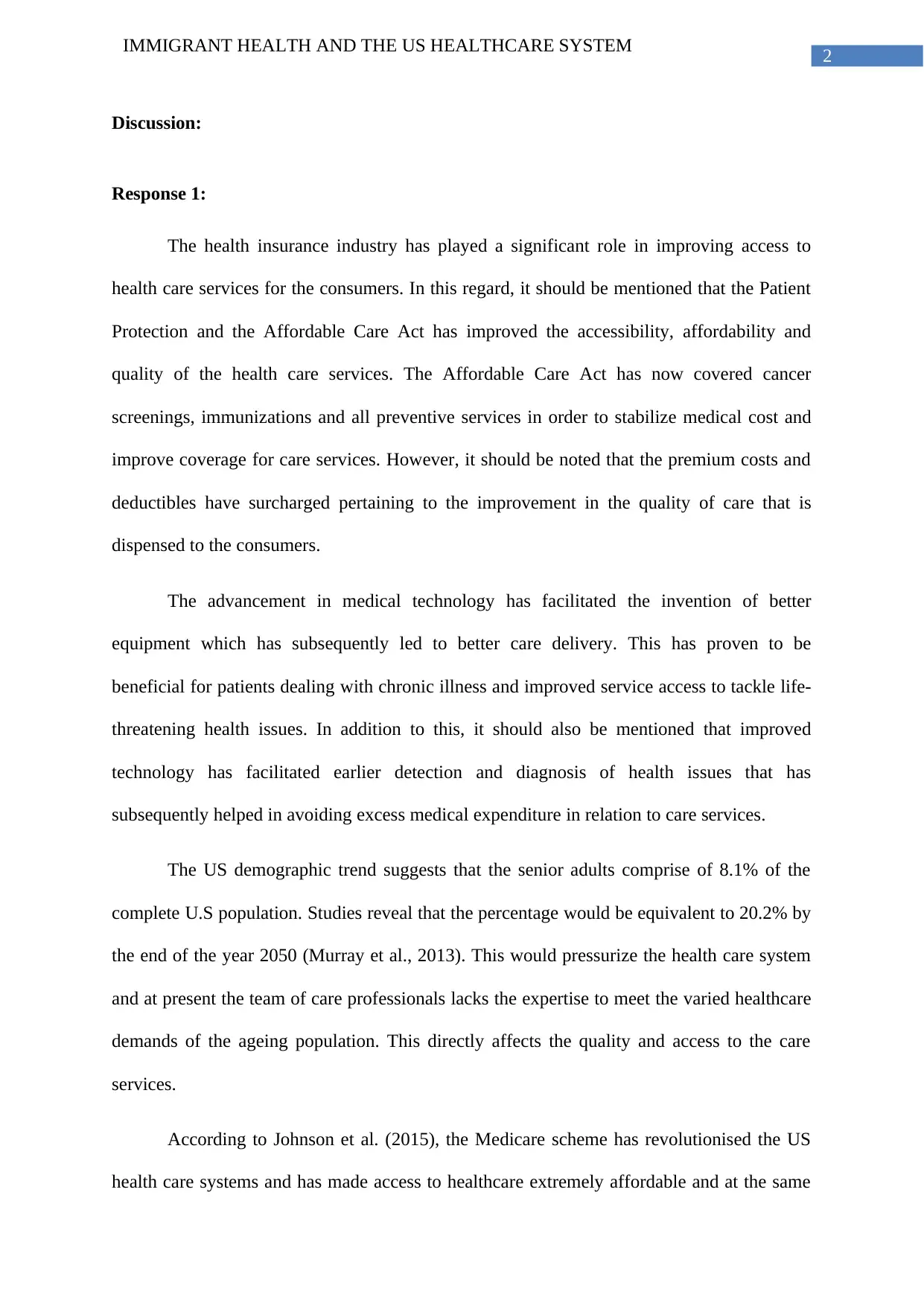
2
IMMIGRANT HEALTH AND THE US HEALTHCARE SYSTEM
Discussion:
Response 1:
The health insurance industry has played a significant role in improving access to
health care services for the consumers. In this regard, it should be mentioned that the Patient
Protection and the Affordable Care Act has improved the accessibility, affordability and
quality of the health care services. The Affordable Care Act has now covered cancer
screenings, immunizations and all preventive services in order to stabilize medical cost and
improve coverage for care services. However, it should be noted that the premium costs and
deductibles have surcharged pertaining to the improvement in the quality of care that is
dispensed to the consumers.
The advancement in medical technology has facilitated the invention of better
equipment which has subsequently led to better care delivery. This has proven to be
beneficial for patients dealing with chronic illness and improved service access to tackle life-
threatening health issues. In addition to this, it should also be mentioned that improved
technology has facilitated earlier detection and diagnosis of health issues that has
subsequently helped in avoiding excess medical expenditure in relation to care services.
The US demographic trend suggests that the senior adults comprise of 8.1% of the
complete U.S population. Studies reveal that the percentage would be equivalent to 20.2% by
the end of the year 2050 (Murray et al., 2013). This would pressurize the health care system
and at present the team of care professionals lacks the expertise to meet the varied healthcare
demands of the ageing population. This directly affects the quality and access to the care
services.
According to Johnson et al. (2015), the Medicare scheme has revolutionised the US
health care systems and has made access to healthcare extremely affordable and at the same
IMMIGRANT HEALTH AND THE US HEALTHCARE SYSTEM
Discussion:
Response 1:
The health insurance industry has played a significant role in improving access to
health care services for the consumers. In this regard, it should be mentioned that the Patient
Protection and the Affordable Care Act has improved the accessibility, affordability and
quality of the health care services. The Affordable Care Act has now covered cancer
screenings, immunizations and all preventive services in order to stabilize medical cost and
improve coverage for care services. However, it should be noted that the premium costs and
deductibles have surcharged pertaining to the improvement in the quality of care that is
dispensed to the consumers.
The advancement in medical technology has facilitated the invention of better
equipment which has subsequently led to better care delivery. This has proven to be
beneficial for patients dealing with chronic illness and improved service access to tackle life-
threatening health issues. In addition to this, it should also be mentioned that improved
technology has facilitated earlier detection and diagnosis of health issues that has
subsequently helped in avoiding excess medical expenditure in relation to care services.
The US demographic trend suggests that the senior adults comprise of 8.1% of the
complete U.S population. Studies reveal that the percentage would be equivalent to 20.2% by
the end of the year 2050 (Murray et al., 2013). This would pressurize the health care system
and at present the team of care professionals lacks the expertise to meet the varied healthcare
demands of the ageing population. This directly affects the quality and access to the care
services.
According to Johnson et al. (2015), the Medicare scheme has revolutionised the US
health care systems and has made access to healthcare extremely affordable and at the same
⊘ This is a preview!⊘
Do you want full access?
Subscribe today to unlock all pages.

Trusted by 1+ million students worldwide
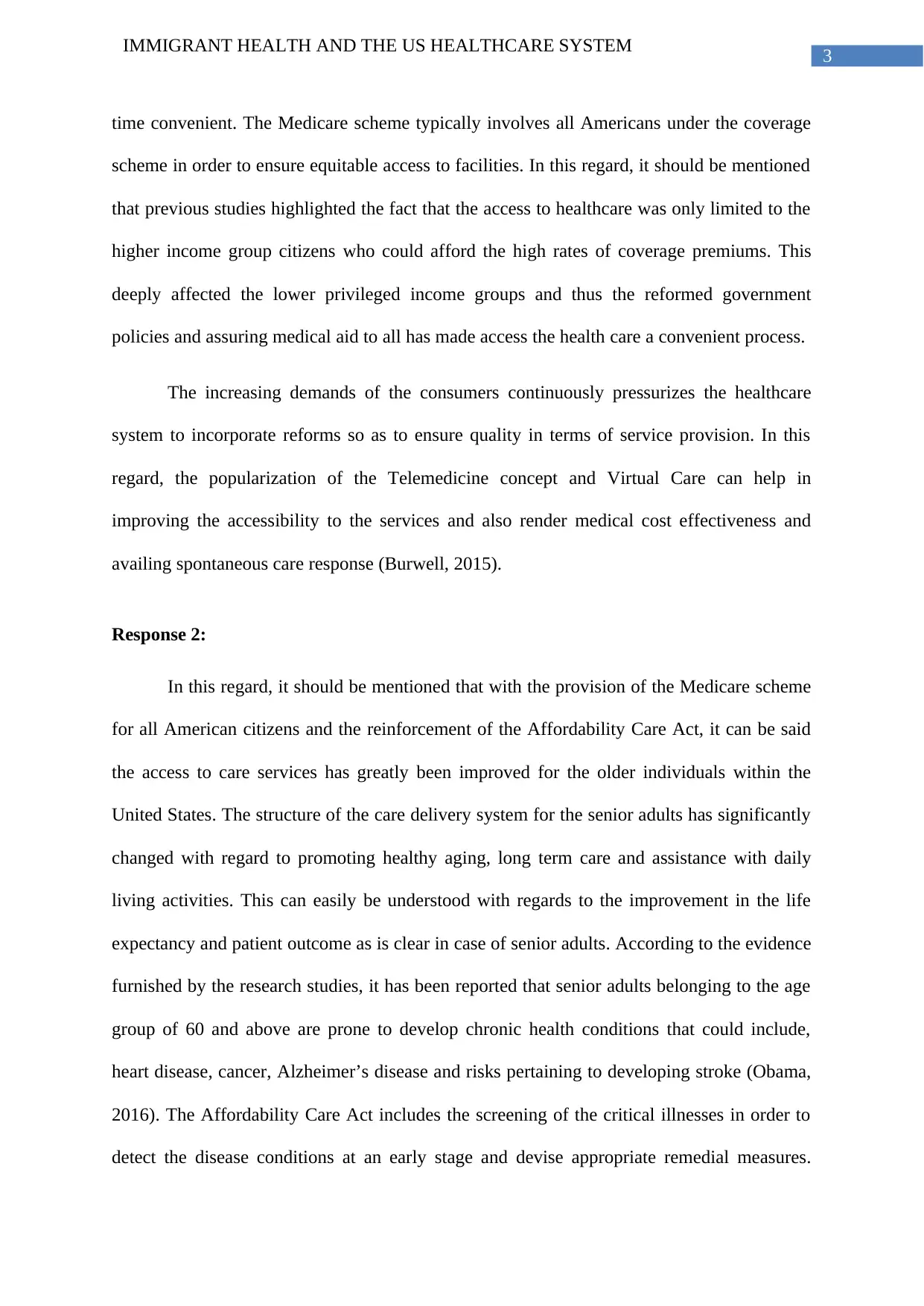
3
IMMIGRANT HEALTH AND THE US HEALTHCARE SYSTEM
time convenient. The Medicare scheme typically involves all Americans under the coverage
scheme in order to ensure equitable access to facilities. In this regard, it should be mentioned
that previous studies highlighted the fact that the access to healthcare was only limited to the
higher income group citizens who could afford the high rates of coverage premiums. This
deeply affected the lower privileged income groups and thus the reformed government
policies and assuring medical aid to all has made access the health care a convenient process.
The increasing demands of the consumers continuously pressurizes the healthcare
system to incorporate reforms so as to ensure quality in terms of service provision. In this
regard, the popularization of the Telemedicine concept and Virtual Care can help in
improving the accessibility to the services and also render medical cost effectiveness and
availing spontaneous care response (Burwell, 2015).
Response 2:
In this regard, it should be mentioned that with the provision of the Medicare scheme
for all American citizens and the reinforcement of the Affordability Care Act, it can be said
the access to care services has greatly been improved for the older individuals within the
United States. The structure of the care delivery system for the senior adults has significantly
changed with regard to promoting healthy aging, long term care and assistance with daily
living activities. This can easily be understood with regards to the improvement in the life
expectancy and patient outcome as is clear in case of senior adults. According to the evidence
furnished by the research studies, it has been reported that senior adults belonging to the age
group of 60 and above are prone to develop chronic health conditions that could include,
heart disease, cancer, Alzheimer’s disease and risks pertaining to developing stroke (Obama,
2016). The Affordability Care Act includes the screening of the critical illnesses in order to
detect the disease conditions at an early stage and devise appropriate remedial measures.
IMMIGRANT HEALTH AND THE US HEALTHCARE SYSTEM
time convenient. The Medicare scheme typically involves all Americans under the coverage
scheme in order to ensure equitable access to facilities. In this regard, it should be mentioned
that previous studies highlighted the fact that the access to healthcare was only limited to the
higher income group citizens who could afford the high rates of coverage premiums. This
deeply affected the lower privileged income groups and thus the reformed government
policies and assuring medical aid to all has made access the health care a convenient process.
The increasing demands of the consumers continuously pressurizes the healthcare
system to incorporate reforms so as to ensure quality in terms of service provision. In this
regard, the popularization of the Telemedicine concept and Virtual Care can help in
improving the accessibility to the services and also render medical cost effectiveness and
availing spontaneous care response (Burwell, 2015).
Response 2:
In this regard, it should be mentioned that with the provision of the Medicare scheme
for all American citizens and the reinforcement of the Affordability Care Act, it can be said
the access to care services has greatly been improved for the older individuals within the
United States. The structure of the care delivery system for the senior adults has significantly
changed with regard to promoting healthy aging, long term care and assistance with daily
living activities. This can easily be understood with regards to the improvement in the life
expectancy and patient outcome as is clear in case of senior adults. According to the evidence
furnished by the research studies, it has been reported that senior adults belonging to the age
group of 60 and above are prone to develop chronic health conditions that could include,
heart disease, cancer, Alzheimer’s disease and risks pertaining to developing stroke (Obama,
2016). The Affordability Care Act includes the screening of the critical illnesses in order to
detect the disease conditions at an early stage and devise appropriate remedial measures.
Paraphrase This Document
Need a fresh take? Get an instant paraphrase of this document with our AI Paraphraser
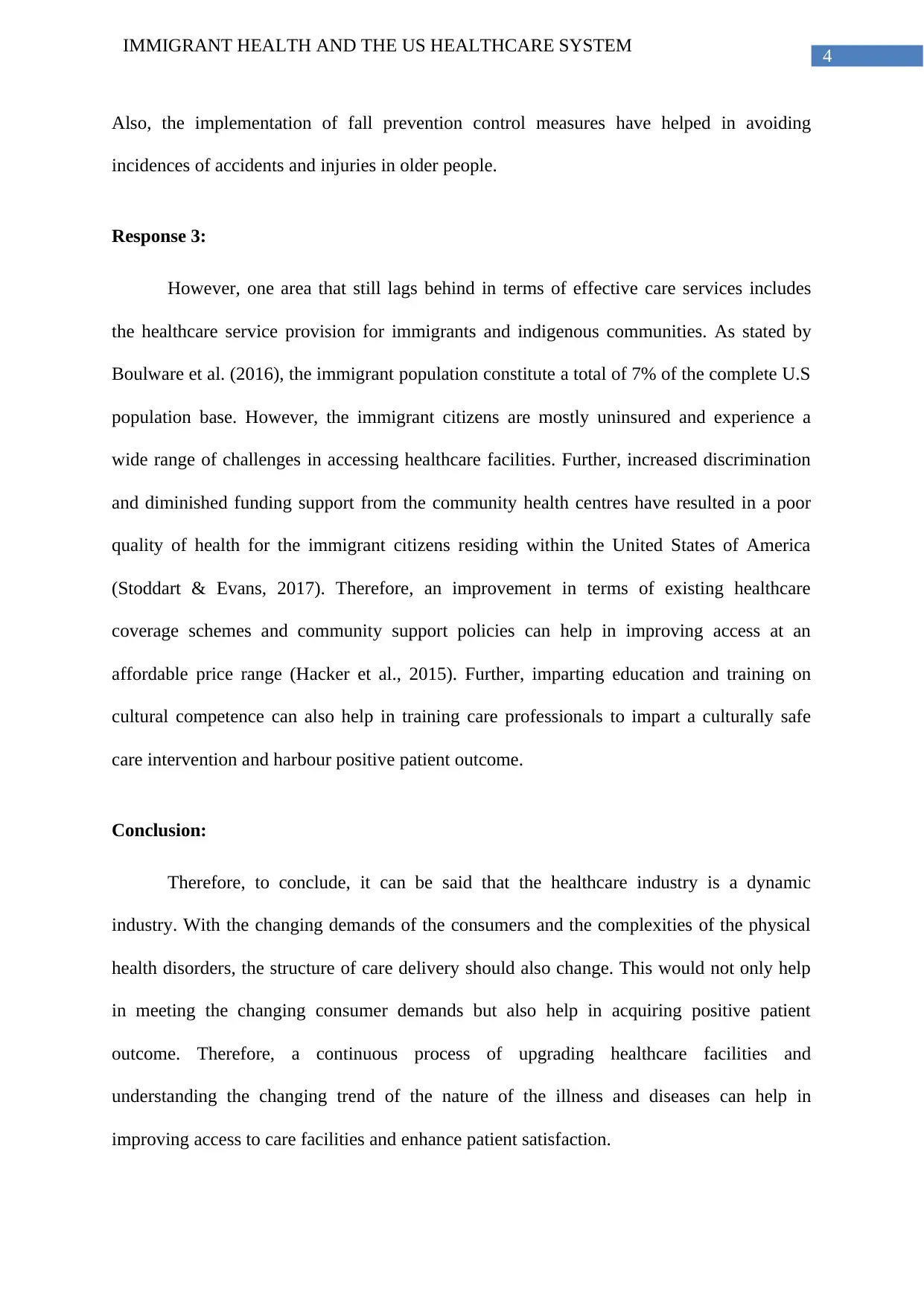
4
IMMIGRANT HEALTH AND THE US HEALTHCARE SYSTEM
Also, the implementation of fall prevention control measures have helped in avoiding
incidences of accidents and injuries in older people.
Response 3:
However, one area that still lags behind in terms of effective care services includes
the healthcare service provision for immigrants and indigenous communities. As stated by
Boulware et al. (2016), the immigrant population constitute a total of 7% of the complete U.S
population base. However, the immigrant citizens are mostly uninsured and experience a
wide range of challenges in accessing healthcare facilities. Further, increased discrimination
and diminished funding support from the community health centres have resulted in a poor
quality of health for the immigrant citizens residing within the United States of America
(Stoddart & Evans, 2017). Therefore, an improvement in terms of existing healthcare
coverage schemes and community support policies can help in improving access at an
affordable price range (Hacker et al., 2015). Further, imparting education and training on
cultural competence can also help in training care professionals to impart a culturally safe
care intervention and harbour positive patient outcome.
Conclusion:
Therefore, to conclude, it can be said that the healthcare industry is a dynamic
industry. With the changing demands of the consumers and the complexities of the physical
health disorders, the structure of care delivery should also change. This would not only help
in meeting the changing consumer demands but also help in acquiring positive patient
outcome. Therefore, a continuous process of upgrading healthcare facilities and
understanding the changing trend of the nature of the illness and diseases can help in
improving access to care facilities and enhance patient satisfaction.
IMMIGRANT HEALTH AND THE US HEALTHCARE SYSTEM
Also, the implementation of fall prevention control measures have helped in avoiding
incidences of accidents and injuries in older people.
Response 3:
However, one area that still lags behind in terms of effective care services includes
the healthcare service provision for immigrants and indigenous communities. As stated by
Boulware et al. (2016), the immigrant population constitute a total of 7% of the complete U.S
population base. However, the immigrant citizens are mostly uninsured and experience a
wide range of challenges in accessing healthcare facilities. Further, increased discrimination
and diminished funding support from the community health centres have resulted in a poor
quality of health for the immigrant citizens residing within the United States of America
(Stoddart & Evans, 2017). Therefore, an improvement in terms of existing healthcare
coverage schemes and community support policies can help in improving access at an
affordable price range (Hacker et al., 2015). Further, imparting education and training on
cultural competence can also help in training care professionals to impart a culturally safe
care intervention and harbour positive patient outcome.
Conclusion:
Therefore, to conclude, it can be said that the healthcare industry is a dynamic
industry. With the changing demands of the consumers and the complexities of the physical
health disorders, the structure of care delivery should also change. This would not only help
in meeting the changing consumer demands but also help in acquiring positive patient
outcome. Therefore, a continuous process of upgrading healthcare facilities and
understanding the changing trend of the nature of the illness and diseases can help in
improving access to care facilities and enhance patient satisfaction.
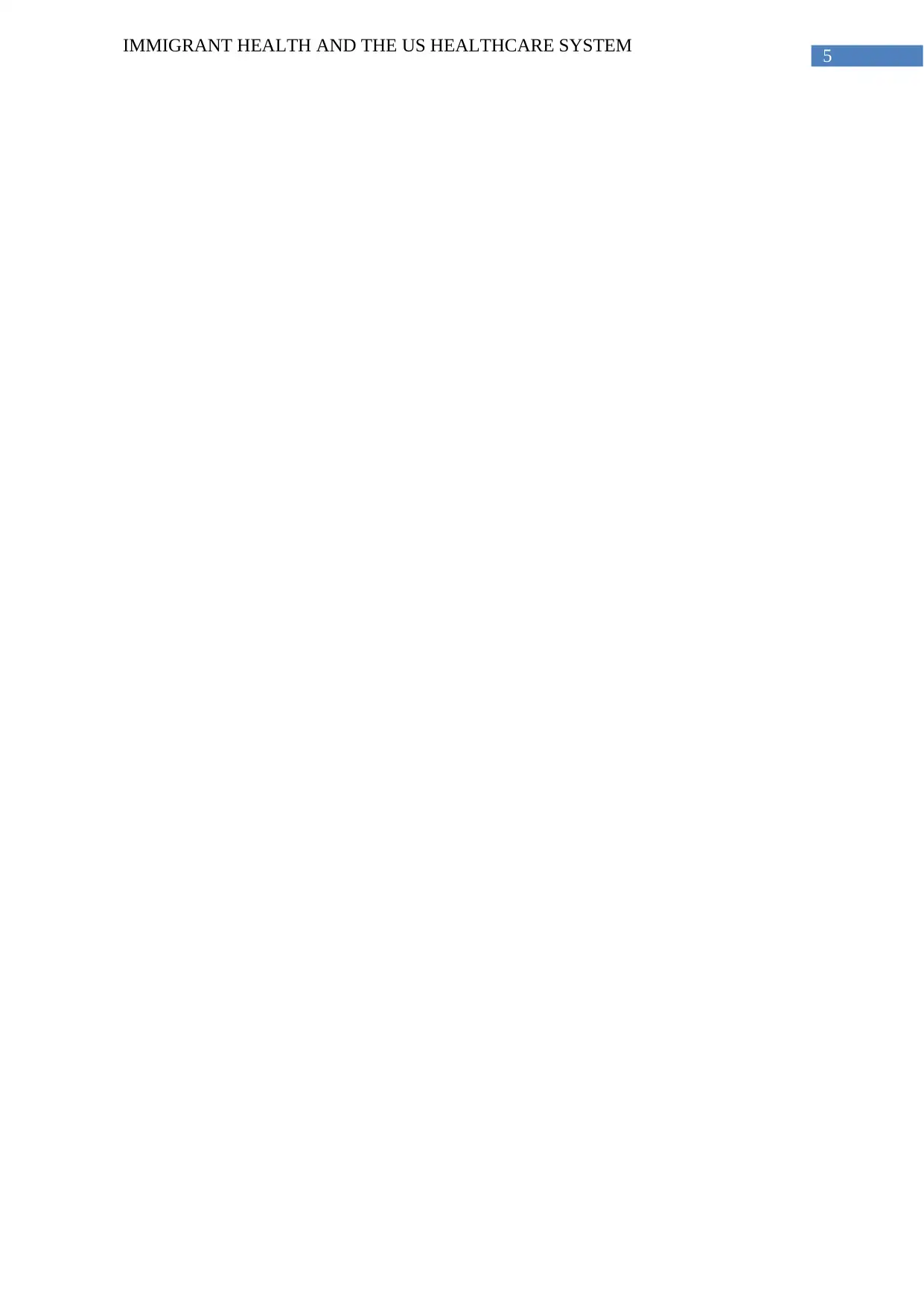
5
IMMIGRANT HEALTH AND THE US HEALTHCARE SYSTEM
IMMIGRANT HEALTH AND THE US HEALTHCARE SYSTEM
⊘ This is a preview!⊘
Do you want full access?
Subscribe today to unlock all pages.

Trusted by 1+ million students worldwide
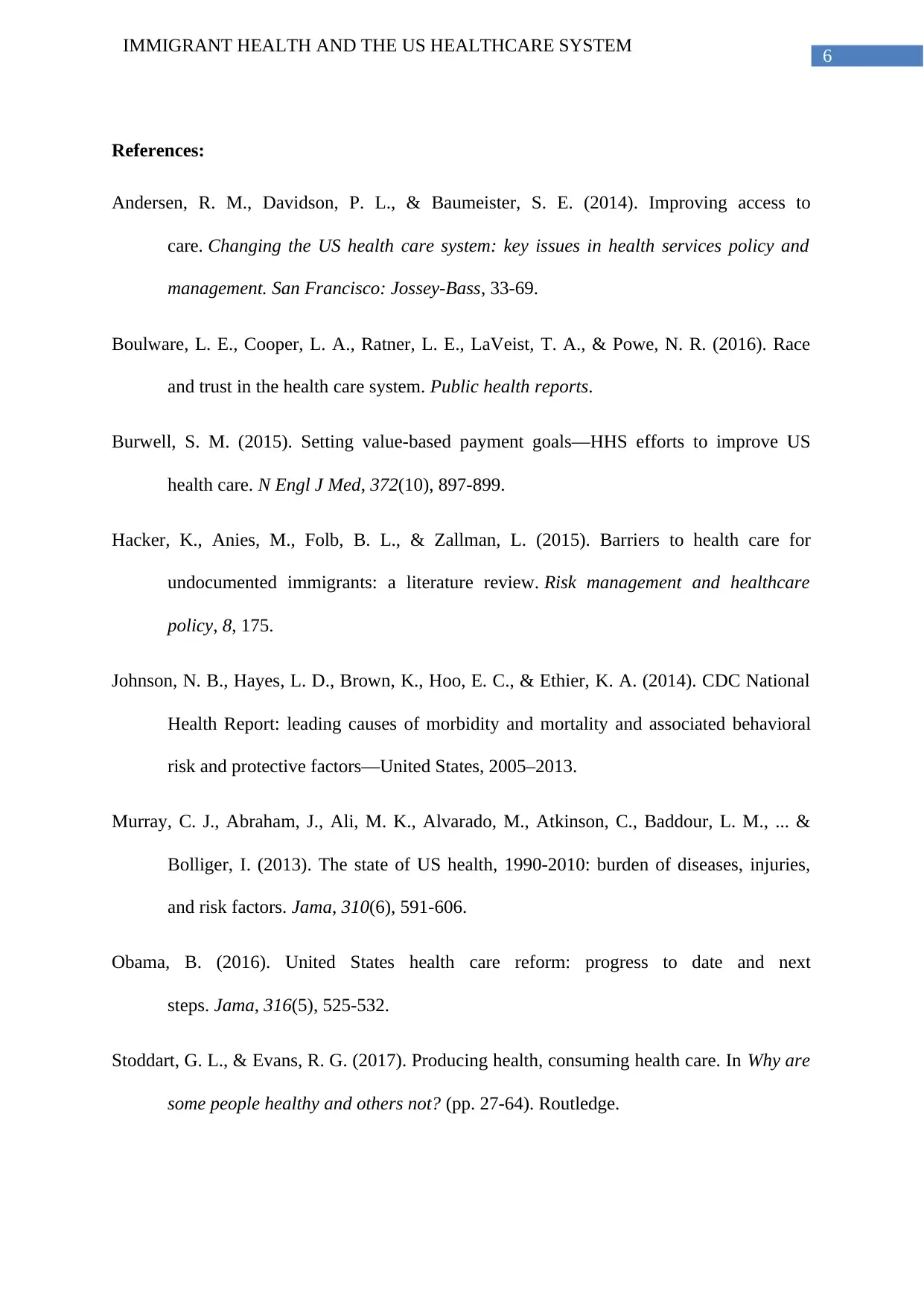
6
IMMIGRANT HEALTH AND THE US HEALTHCARE SYSTEM
References:
Andersen, R. M., Davidson, P. L., & Baumeister, S. E. (2014). Improving access to
care. Changing the US health care system: key issues in health services policy and
management. San Francisco: Jossey-Bass, 33-69.
Boulware, L. E., Cooper, L. A., Ratner, L. E., LaVeist, T. A., & Powe, N. R. (2016). Race
and trust in the health care system. Public health reports.
Burwell, S. M. (2015). Setting value-based payment goals—HHS efforts to improve US
health care. N Engl J Med, 372(10), 897-899.
Hacker, K., Anies, M., Folb, B. L., & Zallman, L. (2015). Barriers to health care for
undocumented immigrants: a literature review. Risk management and healthcare
policy, 8, 175.
Johnson, N. B., Hayes, L. D., Brown, K., Hoo, E. C., & Ethier, K. A. (2014). CDC National
Health Report: leading causes of morbidity and mortality and associated behavioral
risk and protective factors—United States, 2005–2013.
Murray, C. J., Abraham, J., Ali, M. K., Alvarado, M., Atkinson, C., Baddour, L. M., ... &
Bolliger, I. (2013). The state of US health, 1990-2010: burden of diseases, injuries,
and risk factors. Jama, 310(6), 591-606.
Obama, B. (2016). United States health care reform: progress to date and next
steps. Jama, 316(5), 525-532.
Stoddart, G. L., & Evans, R. G. (2017). Producing health, consuming health care. In Why are
some people healthy and others not? (pp. 27-64). Routledge.
IMMIGRANT HEALTH AND THE US HEALTHCARE SYSTEM
References:
Andersen, R. M., Davidson, P. L., & Baumeister, S. E. (2014). Improving access to
care. Changing the US health care system: key issues in health services policy and
management. San Francisco: Jossey-Bass, 33-69.
Boulware, L. E., Cooper, L. A., Ratner, L. E., LaVeist, T. A., & Powe, N. R. (2016). Race
and trust in the health care system. Public health reports.
Burwell, S. M. (2015). Setting value-based payment goals—HHS efforts to improve US
health care. N Engl J Med, 372(10), 897-899.
Hacker, K., Anies, M., Folb, B. L., & Zallman, L. (2015). Barriers to health care for
undocumented immigrants: a literature review. Risk management and healthcare
policy, 8, 175.
Johnson, N. B., Hayes, L. D., Brown, K., Hoo, E. C., & Ethier, K. A. (2014). CDC National
Health Report: leading causes of morbidity and mortality and associated behavioral
risk and protective factors—United States, 2005–2013.
Murray, C. J., Abraham, J., Ali, M. K., Alvarado, M., Atkinson, C., Baddour, L. M., ... &
Bolliger, I. (2013). The state of US health, 1990-2010: burden of diseases, injuries,
and risk factors. Jama, 310(6), 591-606.
Obama, B. (2016). United States health care reform: progress to date and next
steps. Jama, 316(5), 525-532.
Stoddart, G. L., & Evans, R. G. (2017). Producing health, consuming health care. In Why are
some people healthy and others not? (pp. 27-64). Routledge.
1 out of 7
Related Documents
Your All-in-One AI-Powered Toolkit for Academic Success.
+13062052269
info@desklib.com
Available 24*7 on WhatsApp / Email
![[object Object]](/_next/static/media/star-bottom.7253800d.svg)
Unlock your academic potential
Copyright © 2020–2025 A2Z Services. All Rights Reserved. Developed and managed by ZUCOL.





